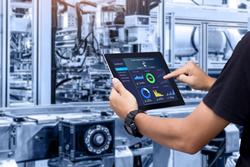Assessing the Potential of Robotics and Artificial Intelligence
 Global X for Nasdaq: Recent technological advancements in robotics and artificial intelligence (AI) are disrupting a range of industries from manufacturing, to health care, defense, and transportation.
Global X for Nasdaq: Recent technological advancements in robotics and artificial intelligence (AI) are disrupting a range of industries from manufacturing, to health care, defense, and transportation.
- What are robotics and AI?
- What are the drivers of growth within robotics and AI?
- Which sectors are being disrupted by these technologies?
- What types of companies are expected to benefit most?
What Are Robotics and AI?
Robotics is a term for a mechanical device designed to perform an operation or task. These engineering feats are increasingly joined by advancements in software, which allow computers to work, learn, and problem-solve- an area of computer science called artificial intelligence. Together, these technologies are revolutionizing the way we complete tasks, analyze data, and make decisions.
Many don’t realize just how little human oversight is required of today’s most advanced robots. One Japanese factory has been running in “lights out” mode for more than 15 years, meaning there are no human factory workers. Automated plants like this are capable of manufacturing everything from electric razors to even other robots. In addition, breakthroughs in AI allow computers to perform complex tasks by drawing on various data sets and inputs. For example, IBM’s Watson computer is able to generate sports highlight reels by analyzing crowd noises and player gestures.2 Joining the mechanical abilities of robotics with the intelligence of AI has resulted in machines capable of cleaning, cooking, driving, and caretaking among other human-like tasks. Full Article:
Comments (0)
This post does not have any comments. Be the first to leave a comment below.
Featured Product

